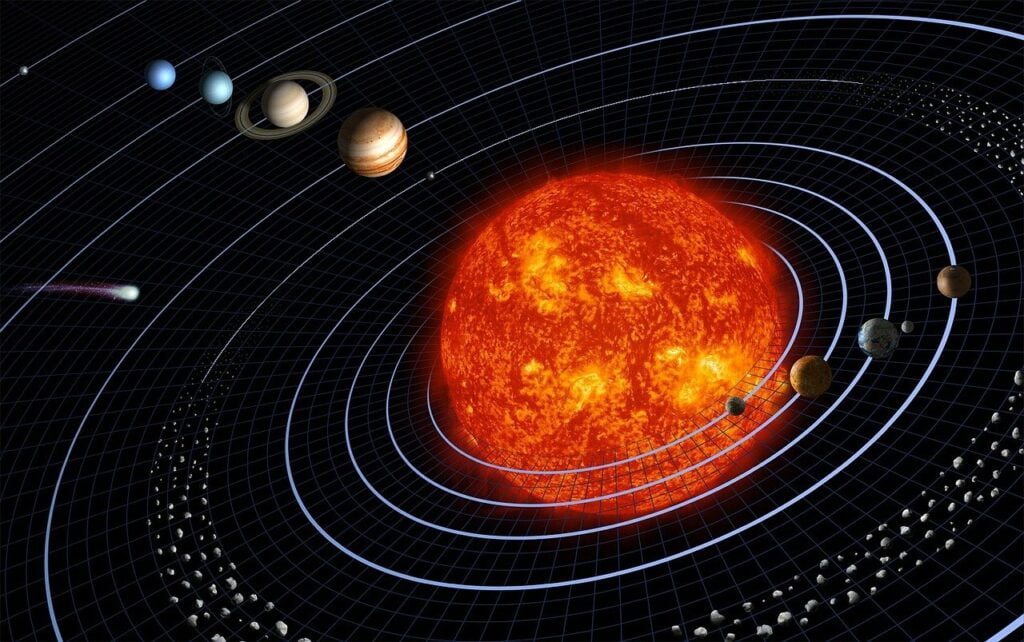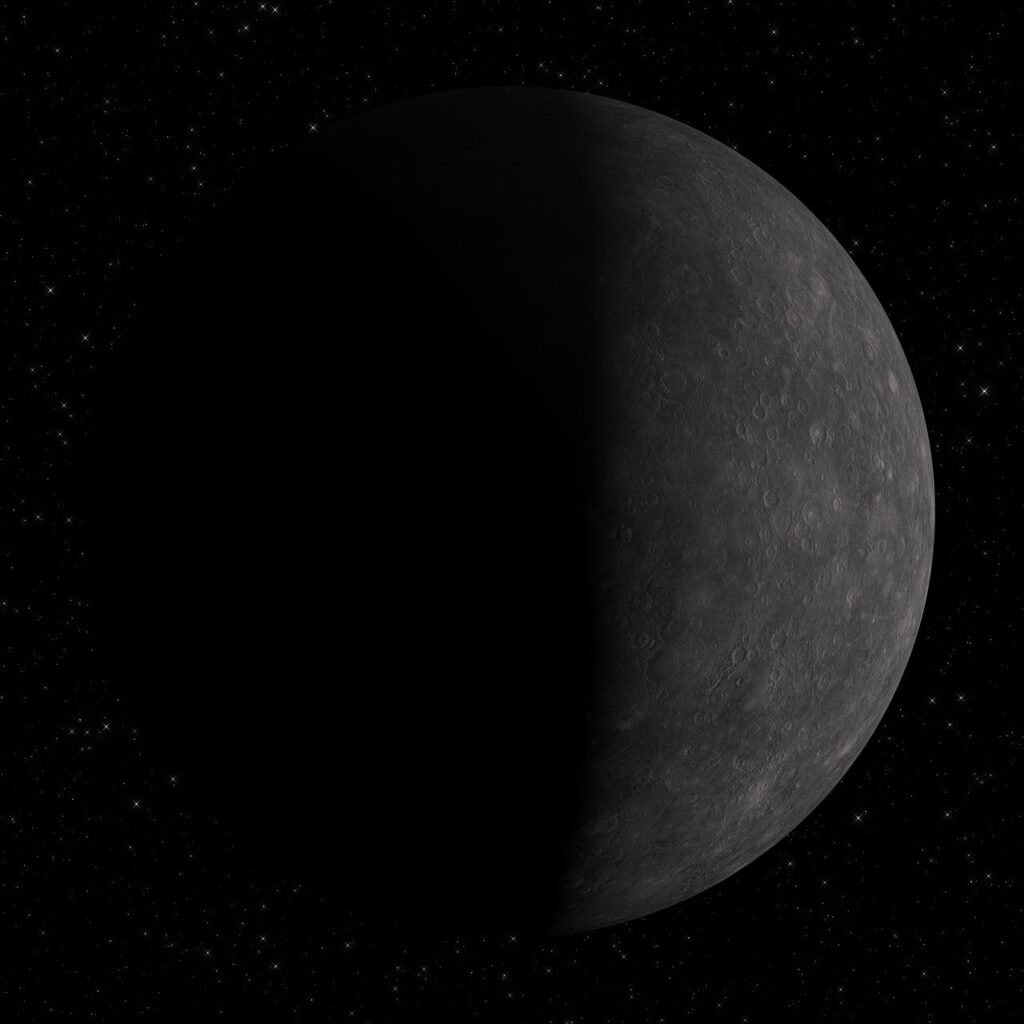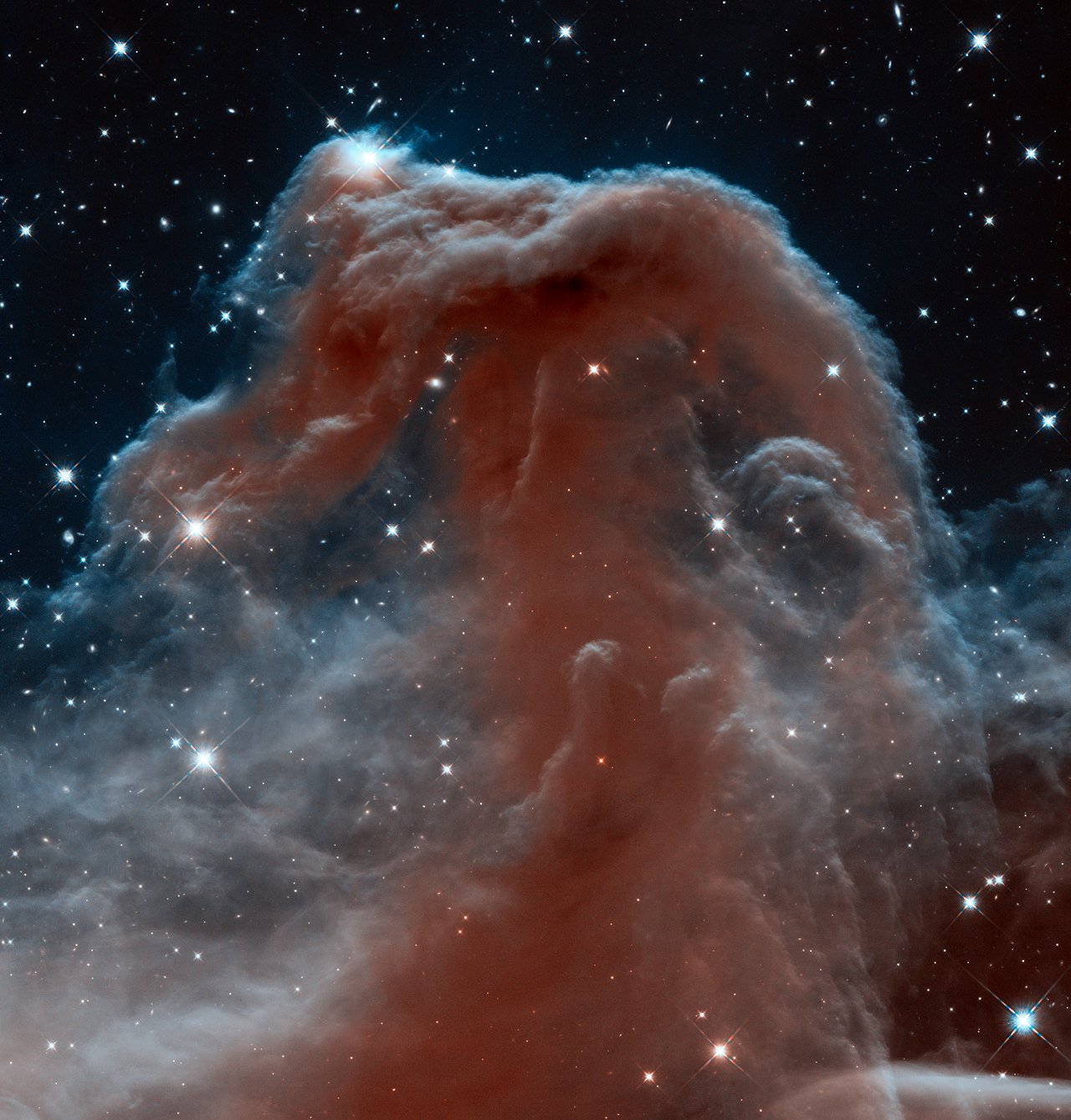
Gazing towards the constellation Orion, a familiar hunter depicted in the night sky, our eyes might be drawn to the three bright stars forming his belt. But nestled just south of the easternmost belt star, Alnitak, lies a far more ethereal sight: the Horsehead Nebula. This dark, wispy cloud, shaped like its namesake steed, has captivated astronomers and the public alike for centuries. But what secrets does this cosmic dust cloud hold? Let’s embark on a journey to unravel the mysteries of the Horsehead Nebula.
Born in Starlight, Sculpted by Darkness
The Horsehead Nebula, also known as Barnard 33 or IC 434, resides approximately 1,350 light-years away from Earth. This means the light we see today left the nebula over a millennium ago! Despite its relatively close proximity, the Horsehead Nebula appears small in the grand scheme of the cosmos, spanning only about 13 light-years across [1]. Yet, within its compact form lies a complex interplay of light and dust.
The nebula primarily consists of cold molecular hydrogen gas, peppered with dust grains composed of elements like carbon, oxygen, and silicon. This dusty veil acts like a cosmic curtain, absorbing the intense ultraviolet radiation from nearby hot young stars. This absorption is what carves out the iconic horsehead shape, silhouetted against the glowing emission nebula, IC 434, behind it.
A Celestial Legacy: Unveiling the Horsehead’s Nebula Secrets
The Horsehead Nebula wasn’t always known by its evocative name. Its discovery is attributed to American astronomer Edward Emerson Barnard in 1894, who documented it in his catalog of dark nebulae. The nickname “Horsehead Nebula” likely arose due to its distinct shape, becoming widely used by the early 20th century.
But why is this dusty cloud so captivating? The significance of the Horsehead Nebula lies in its role as a stellar nursery. Embedded within its swirling tendrils are nascent stars, just beginning their fiery journeys. Studying the Horsehead Nebula allows us to witness the earliest stages of star formation, providing valuable insights into how stars like our own Sun are born.
Formation, Evolution, and the Future of the Horsehead Nebula
Having delved into the Horsehead Nebula’s basic properties and history, let’s step back in time to explore its dramatic birth and peer into its uncertain future.
From Galactic Gaseousness to Cosmic Horse
The story of the Horsehead Nebula’s beginnings starts millions of years ago within the Orion Molecular Cloud Complex, a vast reservoir of dust and gas. Gravitational forces within this giant cloud triggered the collapse of denser regions, eventually leading to the formation of the Horsehead Nebula. However, the exact mechanism behind its unique shape remains a subject of ongoing research.
Two dominant theories prevail: one suggests that shockwaves from nearby exploding stars sculpted the nebula’s form, while another proposes that the interplay of stellar winds and radiation played a key role [2]. Regardless of the precise mechanism, the Horsehead Nebula stands as a testament to the dynamic and chaotic nature of star formation.
Birthing New Stars within the Cosmic Horse
The Horsehead Nebula isn’t just a celestial sculpture; it’s a bustling stellar nursery. Deep within its dusty folds, dense pockets of gas and dust known as “cores” provide the ideal environment for new stars to be born. These cores collapse under their own gravity, heating up and eventually igniting nuclear fusion, marking the birth of a star.
Intriguingly, recent observations have revealed several young stars, known as Herbig-Haro objects, embedded within the Horsehead Nebula. These fledgling stars are still in their infancy, spewing out jets of gas and dust that illuminate the surrounding nebula, contributing to its dynamic and ever-changing appearance.
The Horsehead Nebula’s Uncertain Fate
The Horsehead Nebula’s existence isn’t static. The harsh ultraviolet radiation from nearby hot stars like Sigma Orionis bombards the nebula, slowly eroding its dusty tendrils. This erosion process, coupled with the ongoing birth of stars within the nebula itself, creates a delicate balance between destruction and creation.
Predicting the Horsehead Nebula’s fate is challenging. Estimates suggest it may survive for another million years before being completely dissolved by stellar radiation. However, the dynamic interplay of forces within the nebula, along with potential future supernovae in the vicinity, could significantly impact this timeline.
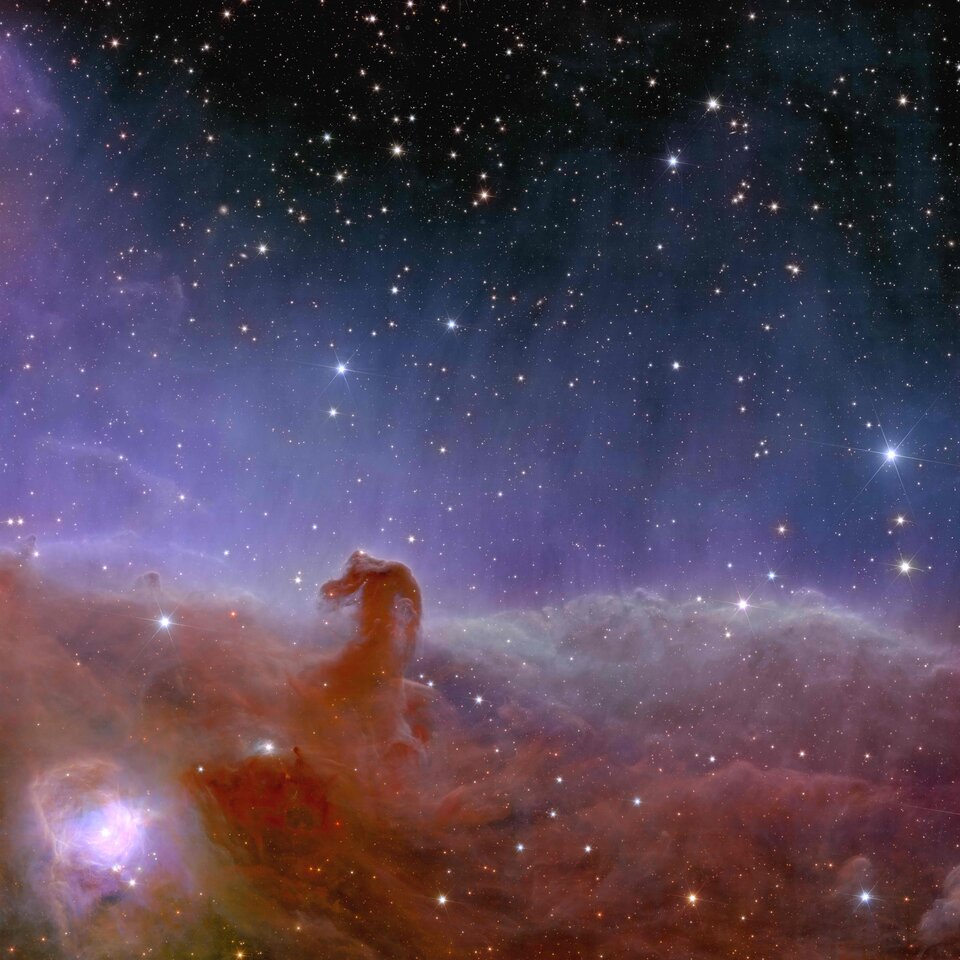
Structure and Composition of the Horsehead Nebula
Having journeyed through the Horsehead Nebula’s origins and its role in stellar birth, let’s delve deeper into its intricate structure and the diverse materials that make it up.
Horsehead’s Internal Landscape
The Horsehead Nebula isn’t a monolithic entity; it’s a complex interplay of different regions. The most prominent feature is the iconic dark cloud itself, composed primarily of cold molecular hydrogen gas and dust grains. This dense region acts like a cosmic curtain, blocking the light from the emission nebula, IC 434, located behind it.
IC 434, bathed in the ultraviolet light from nearby stars, glows brightly, contrasting beautifully with the Horsehead’s darkness. Interestingly, within the Horsehead cloud itself, there are substructures like dense cores, where new stars are forming, and filaments, wispy tendrils of dust and gas.
A Chemical Tapestry: The Elements that Build the Horsehead
But what exactly is the stuff that makes up the Horsehead Nebula? The primary constituent is molecular hydrogen, making up about 99% of its mass. However, the remaining 1% packs a punch. Dust grains composed of elements like carbon, oxygen, silicon, and iron are sprinkled throughout the nebula, influencing its opacity and contributing to its intricate structure.
Interestingly, recent observations have revealed a rich tapestry of molecules beyond hydrogen, including carbon monoxide, water vapor, and even organic molecules like methanol and formaldehyde. These complex molecules hint at the potential for prebiotic chemistry within the nebula, offering exciting possibilities for understanding the origins of life.
The Impact of Jets and Herbig-Haro Objects
The Horsehead Nebula isn’t a passive bystander in its cosmic neighborhood. As young stars within it ignite, they often spew out powerful jets of gas and dust known as Herbig-Haro objects. These energetic jets not only illuminate the surrounding nebula but also interact with the dusty tendrils, potentially triggering further star formation or shaping the nebula’s structure.
Understanding the interplay between these jets and the nebula’s structure is crucial for unraveling the complex dance of birth and destruction within the Horsehead. Ongoing research with advanced telescopes promises to shed new light on this dynamic interaction.
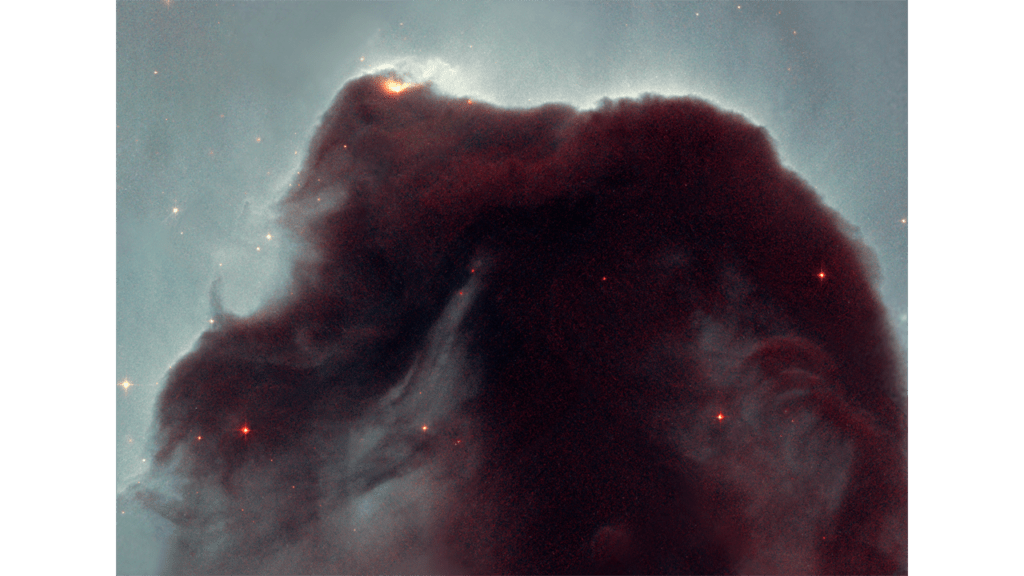
Observing and Researching the Horsehead Nebula
Our exploration of the Horsehead Nebula wouldn’t be complete without understanding how we study this celestial wonder. Buckle up as we delve into the challenges, tools, and exciting discoveries surrounding this cosmic icon.
Overcoming Observational Challenges
Studying the Horsehead Nebula isn’t easy. Its dusty cloak absorbs much of the visible light, making it faint and difficult to observe. Additionally, its location within the cluttered Orion Molecular Cloud Complex further complicates the picture. Thankfully, astronomers have an arsenal of powerful tools at their disposal.
Telescopes and Instruments Peering into the Nebula
Ground-based telescopes like the Keck Observatory and ALMA provide stunning optical and infrared images, revealing the nebula’s intricate structure and the glow of young stars within [1]. However, to truly pierce the dust veil, we need to go beyond.
Space telescopes like Hubble and now, James Webb, offer unparalleled views in ultraviolet, infrared, and even millimeter wavelengths, allowing us to study the nebula’s composition, trace the flow of gas and dust, and witness the birth of new stars in unprecedented detail [2].
Unveiling the Nebula’s Secrets
These powerful tools have led to a treasure trove of discoveries. Recent observations have revealed intricate networks of filaments within the Horsehead, hinting at the processes that sculpt its iconic shape [3]. The detection of complex organic molecules suggests the potential for prebiotic chemistry, raising exciting questions about the origins of life [4].
Furthermore, ongoing research with James Webb promises to revolutionize our understanding. Its unprecedented infrared capabilities will pierce deeper into the dust, unveil the properties of young stars, and potentially discover new objects hidden within the nebula’s depths.
Beyond the Horizon: Future Research and Unanswered Questions
Despite these advancements, mysteries still abound. How exactly did the Horsehead Nebula form? What role do stellar winds and radiation play in its evolution? Are there planets lurking within its dusty tendrils?
Future research with even more powerful telescopes and innovative techniques aims to answer these questions and delve deeper into the nebula’s secrets. The Horsehead Nebula serves as a reminder that there’s still so much to discover in the vastness of space, inspiring us to continue our quest for knowledge and unravel the wonders of the universe.
Conclusion
From its ethereal silhouette against the night sky to its role as a vibrant stellar nursery, the Horsehead Nebula has captivated us for centuries. Through the lens of science, we’ve begun to peel back its dusty layers, unveiling a dynamic and complex world of star formation, intricate chemistry, and cosmic dance.
Our journey has highlighted the challenges of studying this celestial icon, yet with each advancement in technology, new discoveries unfold. From groundbreaking telescopes like James Webb to innovative research techniques, we stand on the precipice of unlocking further secrets.
But the Horsehead Nebula isn’t just a passive object of study; it’s a reminder of the vastness and dynamism of the universe. It challenges us to ask deeper questions about our place in the cosmos and the potential for life beyond our own planet.
As we continue to peer deeper into the nebula’s secrets, we embark on a journey of self-discovery, understanding not only the universe but also our own place within it. The Horsehead Nebula, standing at the intersection of beauty and scientific inquiry, will undoubtedly continue to inspire wonder and propel us forward in our quest for cosmic knowledge.
You may also like
Mercury: The Closest Planet to the Sun
Venus: The Earth’s Twin or a Very Different Planet?
Mars: Comprehensive Exploration, unveiling the Mysteries
Jupiter: A Cosmic Giant – Symphony of Storms
Saturn: A Gaseous Giant with Enthralling Rings and Diverse Moons
Useful information
NASA:
Hubble Space Telescope image of the Horsehead Nebula: https://www.jpl.nasa.gov/images/pia04215-horsehead-nebula
“Horsehead Nebula, Orion’s Cosmic Horse”: https://www.jpl.nasa.gov/images/pia04215-horsehead-nebula
European Space Agency (ESA):
Hubble Space Telescope image of the Horsehead Nebula: https://www.esa.int/Science_Exploration/Space_Science/Herschel/Herschel_and_Hubble_see_the_Horsehead_in_new_light
“Horsehead Nebula: Caught in the Act of Star Formation”: https://www.esa.int/Science_Exploration/Space_Science/Herschel/Herschel_and_Hubble_see_the_Horsehead_in_new_light
National Radio Astronomy Observatory (NRAO):
“ALMA Uncovers Details of Star Formation in the Horsehead Nebula”:

